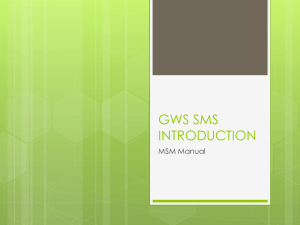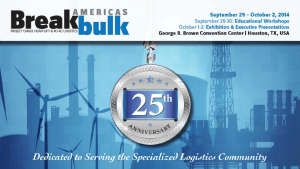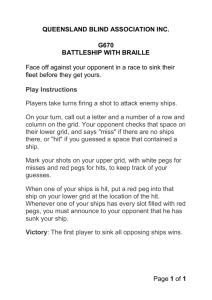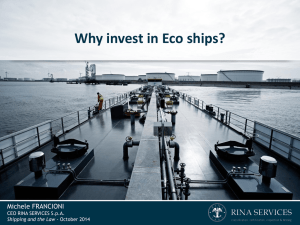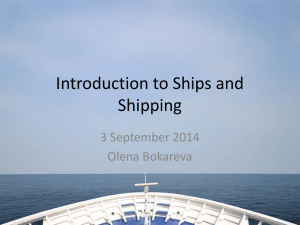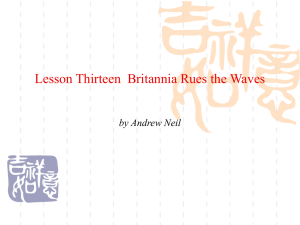MARITIME TRANSPORTATION MANAGEMENT
advertisement
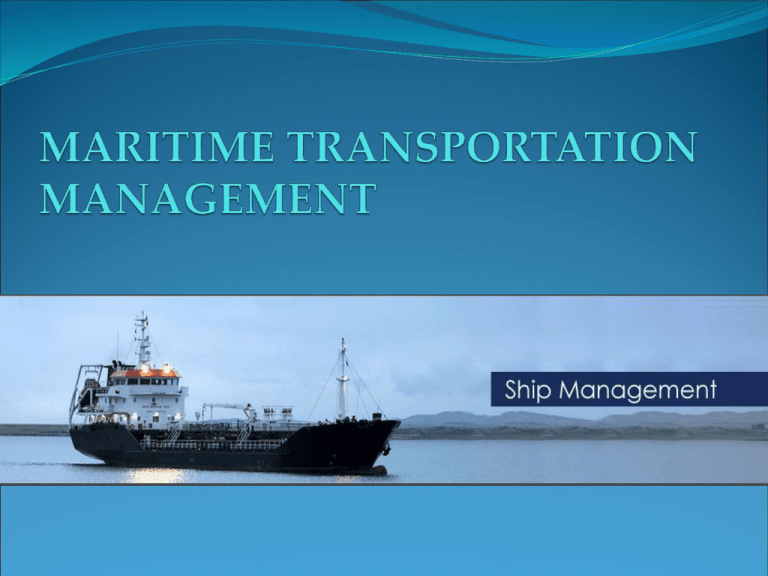
OVERVIEW There are over 140,000 ship and 170,000 ship owner and manager entries in maritime transportation industry. Ships are the least regulated mode of transportation. Ship represents a large capital investment that translates into a large cost per day. Port time is expensive and presents diseconomies of scale (port operations, the optimal size of ship). Generally, the longer a trade route is, the larger the share of sea-days in a voyage, and the larger the optimal ship size will be. OVERVIEW Factors effect the optimal ship size; • the utilization of ship capacity at sea (the “trade balance”), • loading and unloading rates at the ports, • the various costs associated with the ship. A ship is a long-term investment. The useful life of a ship spans 20–30 years. During the life of a ship a lot of market volatility may be encountered (eg; fluctation in freight rates In the short run the owner may reduce the daily variable operating cost by slow steaming (reduction in fuel consumption) the owner may lay up the ship till the market improves. OVERVIEW Lay up a ship significantly reduces its daily variable operating cost. When the market is depressed,owners scrap older ships. The value of a scrapped ship is determined by the weight of its steel (the “lightweight” of the ship) there is high supply of ships for scrap the price paid per ton of scrap drops. SHIP MANAGEMENT Ship management concerns all activities required to operate the ships effectively, except providing equity finance. The Baltic and International Maritime Council (BIMCO) SHIPMAN contract is often used between ship owner and manager. The contract defines the ship management services; Crewing management Technical management Insurance arrangements for hull and machinery, and protection and indemnity (P&I) insurance. Commercial management Other services SHIP MANAGEMENT The operational expenses are used to keep the ship in operation and vary per ship. Manning is the largest component of operational expenses OPEX. Expenses for ship finance and voyage operations are not OPEX. The ship manager is paid for its services with the annual management fee (roughly 5% of annual operational expenses). The ship owner is obliged to indemnify the ship manager against any third-party claims. SHIPPING INDUSTRY There are different classifications in the industry; regularity of service cargo ship charter type SHIPPING INDUSTRY The type of merchant vessel employed on a trade route is determined basically by the traffic carried. There were 3 main divisions; 1. 2. 3. Liner Tramps Specialized vessels (tankers) A tramp may be put on a liner berth to compete for liner cargoes. Conversely liners may at times carry tramp cargoes. MARITIME TRANSPORTATION INDUSTRY DIVISION AS PER TRAFFIC CARRIED TRAMP (BULK CARGO) LINER (GENERAL CARGO) DRY BULK LIQUID BULK DRY CARGO PRIMARY DB Iron Ore Coal Grains Crude Oil Chemicals Wine Veg-Oil etc GENERAL CARGO Car TV Refrigerator All cargoes that needs special handling and storage SECONDARY DB Nickel Chrome Sugar, Salt INDUSTRY DIVISION ACCORDING TO SHIP TYPES Reason for the division; all ships have specific routes and all routes has specific trade and economic issues. Ships mainly divided into 3 groups as; Dry cargo ships (Bulk Ships,Containers,RO/RO etc) Tankers Others Dry bulk ships and tankers are operating in tramp trade. Container ships, MPV,Ro/Ro,Reefer operates in liner trade. History of Liners Scheduled trading began with the advent of steam power in 1820s. When ships became independent from the wind and were much vulnerable to adverse weather, timetabling of services began to be possible as steam power became more reliable and vessels larger In 1860s regular scheduled services were a feature of many main trade routes. Liner trade ships operating on fixed routes with a fixed schedule. Raw materials,manufactured goods mainly carried by container ships which offer; very reliable, tightly scheduled and frequent services with a high level of cargo safety. LINERS Operate on fixed routes and fixed sailing schedules,serving a group of ports. Involves an adequately sized fleet and a fairly large shore establishment. Compose ¼ of seaborne trade. Generally, cargoes loaded in containers. Enables unitization and carry heterogenous products General Cargoes: mainly consumption goods; clothes, TVs,computers. Liners After 90s container trade developed rapidly. Decrease after global crisis in 2008. Vessels are not loaded with one shipper’s cargo Even vessels are not full, voyage is completed as per schedule. Supplied vessel capacity is important. Joint voyage planning, sharing vessel,common use of port equipments; to keep in accordance with the voyage determined and rigth planning of capacity. SHIP TYPES IN LINER TRADE AND THEIR CAPACITIES (2008) CONTAINER SHIPS 4.395 SHIPS, 10.924.515 TEU MULTI PURPOSE VESSELS 2.707 SHIPS, 1.139.859 TEU CONTAINER SHIPS GENERAL CARGO LINER 378 SHIPS, 5.34m. DWT "DEEP SEA" POST PANAMAX (>3.000 TEU) 1.318 SHIPS 647.786 TEU "MID GROUP" PANAMAX,SUB-PANAMAX (1-2.999 TEU) 1846 SHIPS 3.359.293 TEU "FEEDER" FEEDER,FEEDERMAX (<1.000 TEU) 1.231 SHIPS 717.436 TEU GENERAL CARGO TRAMP 726 SHIPS, 6.46m DWT CONBULKER 389 SHIPS, 13.20m DWT BARGE/HEAVY LIFT 41 SHIPS, 1.56m DWT RoRo 1.067 SHIPS, 9.54m DWT CAR CARRIERS 650 SHIPS, 9.34m DWT REEFER 1.231 SHIPS, 330.1m CU.FT TRAMP Bulk; unscheduled and irregular shipments Terms: Common trader, general trader, free maritime transportation, unscheduled trader Ready to carry all types of dry bulk cargo from any origin port to destination port at any time and to provide the legacy and safety of the voyage. Cargo based. Low value cargoes: coal,grain,ores, timber; carried in complete shiploads. TRAMP Many of the cargoes are seasonal. Homogenous characteristic, handled and carried in bulk forms. Ships:Mid sized, unequipped and unassigned for regular trade; with two to six holds,substandard. Often family owned companies tend to merge. Engaged under a document called a charter party; on a time or voyage basis. History of Tramps In the ancient times, Romans import grain from North Africa in bulk and threfore they built a special vessel fleet. Since 19th century the world trade volume increases; parallel to this bulk cargo transportation increased in order to reach economies of scale. The trade almost doubled after 90s till today. Main reason; economic growth of China, India and South East Asia at the end of 20th century. Today 80 % of seaborne dry cargo trade is bulk. Mostly bulk ship carries only one commodity at a time and called bulk carrier. They vary in size; a few hundred tonnes cargo carrying up to 300.000 tonnes General Factors Effect Dry Bulk Transportation Demand International trade volume International trade structure Worldwide geographical distribution of raw materials,agricultural and industrial products, finished and semi-finished goods production and consumption places. Essentials that form the market are especially market of the cargo, transportation routes and vessels used in maritime transportation. It’s important to understand the characterisrics of the cargo, its own market and specific routes of the transportation. FIGURES Dry bulk cargo compose; 57% in tons, 47% in ton- miles basis of tramp trade volume. 33% of total maritime transportation in both tons and ton-miles basis. Only dry bulk vessels compose 34% of total world fleet. SPECIALIZED VESSELS Cargo ships designed for carrying a particular commodity as a result of demand. Ore carriers, sugar carriers and the tankers can be the samples. The world’s tanker fleet is divided between tramp operators (under a charter party) and those owned by oil companies eg; BP VLGC). The larger proportion is owned and operated by oil companies and employed on regular routes; operation in this respect similiar with liner operator. SPECIALIZED VESSELS Most independently owned tankers are on longterm charter to the oil companies. There is a worldwide network of tanker routes; Crude oil is transported from the oilfields to refineries; Petroleum and fuel oil from refineries to distribution centers (DCs) and bunkering ports TANKERS Cargo ships designed to carry crude oil, petroleum products,natural gas and chemical substances, liquefied natural gas (LNG), liquefied petroleum gas (LPG), vegoils,wines etc As a Tramp form, tankers have necessary technological infrastructure to carry such goods. Tankers cover 1/3 of world seaborne trade in tons carried. Oil crises,wars,political issues in world arena effects this industry more than the other maritime transportation industries. Therefore, compared to others tanker trade is fluctuating compared to others. TANKERS Countries that export and import are distinct Importers; China, Japan and other Asian countries,European countries, US Exporters;Saudi Arabia and other Middle East countries, Iran, Iraq, United Arab Emirates and Kuwait; Latin America, North Sea countries like England and Norway. Routes are certain and long. Has a freight system; WORLDSCALE. TANKERS The long distances between production and consumption areas effects the demand on transportation of the crude oil. Middle East countries with the 60% petroleum reserves are far from the consumption areas. From Cape of Good Hope to Europe: 12.000 miles; to Japan 6.000 miles Long routes, petroleum (as an important input) demand increase also increases the tanker trade in ton-miles. FIGURES Tankers compose; %43 in tons, 53% in ton-miles basis of tramp trade. 38% of total maritime transportation in ton-miles basis. Considering dry bulk as 33% of total maritime transportation; in ton miles basis tanker has the highest portion. Tanker fleet accounts for 36% of world fleet. LINER AND TRAMP COMPARISON LINER SERVICE CARGO SHIPPER SHIP TYPES VOYAGE FREIGHT MARKET SERVICE COST SERVICE ORGANISATIONS SHIP OPERATION PROFIT Regular and consistent;whether cargo is available or not General cargo (high volume-high value) High variety Heteregenous Partly loads More than one Conventional Liners RO/RO Container Lash Seabee Bacat Mostly more than two ports Mostly "port time" more than "voyage time" Determined EXPENSIVE Freight Conferences Outsiders Operate many vessels Fleet design is a must Fleet size varies upon tonnage requirement and voyage frequency Profit margin is more determined TRAMP Irregular and discontinious if cargo is not available Bulk Cargo (low value) Low variety Homogenous Shiploads Generally one Bulk Carriers Tankers Combined Vessels Conventional Tramps Mostly between two ports Mostly "voyage time" more than "port time" Flexible and may change daily CHEAP Union of Shipowners Possibility to serve with less vessel Service depend on the cargo not the route Profit margin is fluctuating due to market conditions DRY BULK SHIPS AND CAPACITIES DRY BULK CARGO SHIPS HANDYSIZE HANDYMAX PANAMAX CAPESIZE CAPACITY (CLARKSON) 10.000 -40.000 DWT 40.000 -60.000 DWT 60.000 -80.000 DWT 80.000 DWT< CAPACITY (LR-FAIRPLAY) 20.000 -34.999 DWT 35.000 -49.999 DWT 50.000 -79.999 DWT 80.000 DWT< DRY BULK SHIPS AND THEIR CARGOES CARRIERS CARGOES (SHARE IN TOTAL CARRIAGE IN %) IRON ORE COAL GRAIN BAUXITE-ALUMINA PHOSPHATE CAPESIZE 70% 45% 7% PANAMAX 22% 40% 43% 45% 20% HANDY 8% 15% 50% 55% 80% Vessels have their names according to their characteristics. Panamax; the largest vessel that may pass Panama Canal safely. Capesize has the highest capacity and can not pass Suez Canal. Therefore trade route determined round Cape of Good Hope. TANKER CLASSIFICATION TANKERS HANDYSIZE HANDYMAX PANAMAX AFRAMAX SUEZMAX VLCC/ULCC CAPACITY CAPACITY (CLARKSON) (LR-FAIRPLAY) 10.000 -40.000 DWT 20.000 -34.999 DWT 40.000 -60.000 DWT 35.000 -49.999 DWT 60.000 -80.000 DWT 50.000 -79.999 DWT 80.000 - 120.000 DWT 80.000 - 99.999 DWT 120.000-200.000 DWT 100.000 - 149.999 DWT 200.000 DWT < 150.000 - 299.999 DWT/ 300.000 DWT < **AFRAMAX: Average Freight Rate Assessment – Tanker freight tariff system. TANKERS AND THEIR CARGOES CARGOES (SHARE IN TOTAL CARRIAGE IN %) LIQUID TANKERS CRUDE OIL DIRTY PRODUCT CLEAN PRODUCT ULCC/VLCC 60% SUEZMAX 30% 5% AFRAMAX 10% 35% 20% PANAMAX & HANDY 60% 80% Types of Tankers
